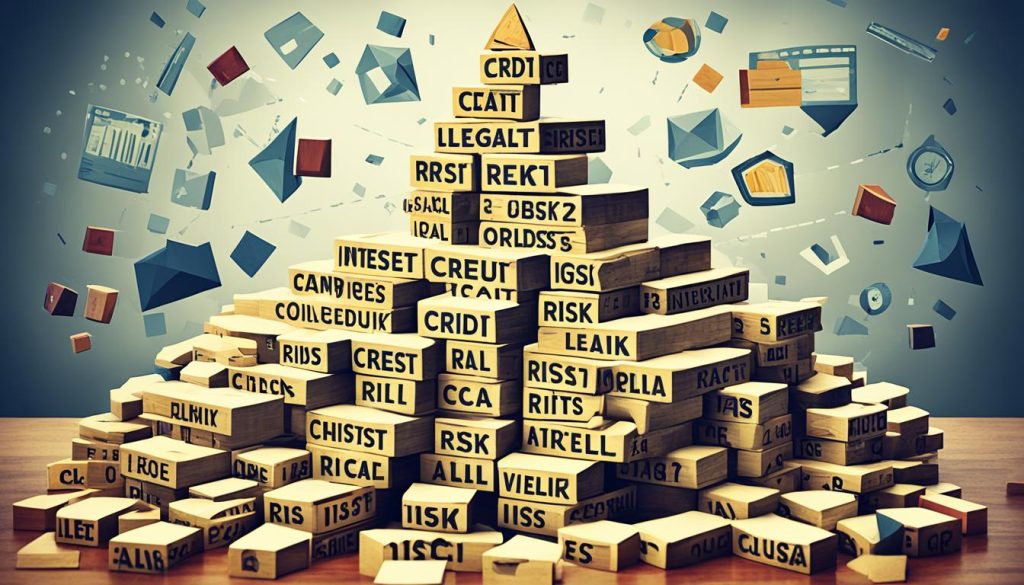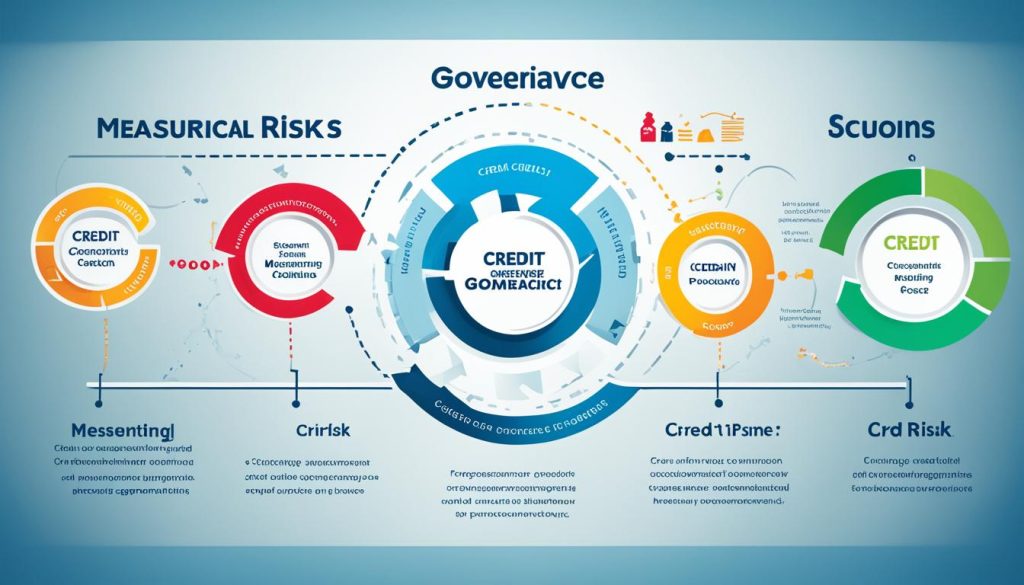Credit risk is a big worry for banks and financial groups. It can cause big losses and mess up cash flows. This can hurt the stability and liquidity of the institution1. So, managing credit risk well is key to keeping the banking sector stable2.
Banks deal with many risks, like credit risk, market risk, operational risk, and reputational risk3. But managing credit risk is especially important. It means checking how likely borrowers are to default on loans1. Good credit risk governance keeps banks stable, follows the law, and keeps their reputation and customer trust safe3.
Key Takeaways
- Credit risk governance is key for the financial stability of banks and financial groups.
- Good credit risk management means looking at borrowers’ creditworthiness and loan default chances.
- Strong credit risk governance helps banks follow the law and keep their reputation and customer trust.
- Banks use strategies like setting lending standards and watching their portfolios to handle credit risk.
- Proper credit risk management gives banks an edge by showing they can handle risks and stay financially stable.
Understanding Credit Risk
Credit risk is a big worry for banks because it’s the chance of losing money if a borrower doesn’t pay back a loan4. This risk comes from many places, like default risk, downgrade risk, and more4. It’s key to know and manage these risks well to keep the financial system stable and follow the rules.
What is Credit Risk?
Credit risk means a lender might not get back the money they lent, causing cash flow problems and extra costs4. This risk is a big reason for banking troubles worldwide because of poor lending standards and risk management4. Loans and other financial tools like derivatives can also carry this risk4.
Types of Credit Risk
Financial institutions face different credit risks:
- Default risk: The chance a borrower won’t pay back a loan or debt.
- Downgrade risk: The risk a borrower’s credit score drops, making borrowing more expensive or harder.
- Credit spread risk: The risk the gap between what a borrower pays and the safe rate goes up, lowering the lender’s investment value.
- Concentration risk: The risk having too much money in one industry or area, making it vulnerable to economic downturns.
- Industry/market risk: The risk economic changes hurt a borrower’s ability to pay back debt.
- Sovereign risk: The risk a government doesn’t pay back its debts or controls the currency, blocking debt repayment.
- Liquidity risk: The risk not being able to sell or trade financial tools fast enough to meet needs or grab new opportunities.
- Interest rate risk: The risk changes in interest rates affect a lender’s assets or the cost of its debts.
- Regulatory risk: The risk new laws or rules hurt a lender’s business or financial duties.
- Moral hazard risk: The risk a borrower takes more risks knowing the lender will face the loss if they default.
Credit risk is the top cause of bank problems worldwide4. The Basel Committee stresses the need for a good credit risk environment and solid lending processes4. Banks should use their own risk rating systems and tools to track credit risk4. Supervisors must check how well banks manage credit risk based on their size and complexity4.
“Settlement risk in financial transactions can lead to substantial losses if not managed effectively.”
Key points for handling credit risk include setting credit risk strategies, following risk management steps, and keeping good controls over credit risk4. Banks need to spot and manage the credit risk in all their products and activities4.
The Importance of Credit Risk Governance
Financial Stability
Effective credit risk governance is key to keeping banks stable and the banking sector secure5. It depends on risk tolerance, governance, and competition within banks5. Now, risk management uses many data sources for better credit decisions and risk control5. Credit risk is now judged based on real-time checks of a company’s portfolio, boosting cash flows and lowering default risk5.
Regulatory Compliance
Credit risk governance is vital for banks to follow the law6. It helps keep capital safe by cutting down loan defaults6. Banks must have strong credit risk management to keep their good name and trust in the market6. Good credit risk management leads to smarter lending and more profits6.
The Dodd-Frank Act brought in rules like stress testing and risk oversight to better manage credit risk after the 2007-2008 crisis7. Governance makes sure banks follow these rules, protecting the credit union and its members7. It sets up policies and frameworks to lower the risk of loan defaults7.
BCT Digital offers the rt360 Credit Risk Suite, using advanced analytics and AI for real-time credit risk insights6. Strong credit risk management helps banks spot, measure, and reduce risks, keeping their capital safe and following the law6.
After the financial crisis, the Federal Reserve and others made strict rules for banks to manage risks well5. A credit risk management framework has five parts: identifying risks, measuring and analyzing them, mitigating them, reporting, and governing5. Identifying risks looks at financial deals like loans, measuring them involves analyzing key indicators, and mitigating means managing credit terms and diversifying risks5. Reporting and measuring are key to keeping risks in check, with credit ratings showing how creditworthy a borrower is5. Governance makes sure employees follow the framework’s rules5.
Good risk assessment puts risks into three categories: preventable, strategic, and external, to manage them well5. Governance helps avoid too much risk-taking, keeps loan portfolios healthy, and encourages responsible lending7.
“The document ‘RM13 Credit Risk Governance – Version 1’ stresses the need for good governance in credit unions for smart operations, accountability, and focusing on members.”7
The credit union board sets the strategy, oversees operations, ensures laws are followed, and promotes a strong risk management culture7. Boards face challenges like managing conflicts, finding the right people, getting the right info, defining support structures, and planning for the future7.
credit risk governance
Credit risk governance is key to managing risks in finance. It’s about having a strong plan to stop, find, measure, watch, and lessen credit risks8. This plan includes setting clear credit rules, using strict credit checks, spreading out credit risks, and doing regular tests and scenarios8.
It also means having a good way to score risks, keeping enough money for loan losses, and having skilled people for credit risk management8.
The three lines of defense framework is central to credit risk governance8. It helps manage risks in a structured way. The way credit is given out affects the quality of credit portfolios and the risk level8.
Checking the creditworthiness of others and the risks of transactions is key. Transactions with higher risks need top-level approval8.
Good credit risk governance needs teamwork between different departments8. It relies on clear rules, skilled staff, proper limits, and strong checks8. Rules should be easy to understand and follow, with good communication and action within the company8.
Strong credit risk governance helps financial institutions manage credit risks better, follow rules, and stay stable8. This is very important with changing rules, economic ups and downs, and new risks in finance9.

As finance deals with these issues, credit risk governance is vital for smart risk management. It builds trust, stability, and steady growth in the market10.
Challenges in Implementing Effective Credit Risk Governance
Financial institutions face many challenges in managing credit risks well. Credit risk is a big risk for banks and financial groups everywhere11. It’s key to beat these challenges to keep finances stable and follow the rules.
Economic Uncertainty
Uncertainty in the economy can make it hard to judge how risky borrowers are. Fast-changing markets need flexible ways to manage credit risk11. Changes in how people act, focusing on a few big customers11, and new lenders and fintech companies add to the problems12.
Regulatory Changes
Rules like the Dodd-Frank Act make things tough for financial groups11. Following new laws and standards, like Basel III and IFRS 9, makes managing credit risk harder. Keeping up with rules12 uses up resources and expertise needed for good credit risk management.
Financial groups also deal with cybersecurity risks11, ESG factors11, issues with data quality and availability11, and risks from other companies11. To overcome these, they need a strong and flexible plan for managing credit risk.
“Effective risk management strategies are highlighted by researchers and practitioners as a necessity post the 2008 global financial crisis.”13

By tackling these issues and using strong credit risk governance, financial groups can get better at handling risks. They can keep up with rules and deal with the complex lending world111213.
Best Practices for Credit Risk Governance
For financial institutions, having strong credit risk governance is key to staying stable and profitable. Credit risk management aims to cut down on loan losses and boost lending profits14. It’s about using a mix of proven methods and techniques.
Robust Credit Policies and Procedures
Financial institutions need to create and stick to detailed credit policies and procedures. These should match their strategic goals and how much risk they can take on. Having clear rules for credit applications helps in better risk assessment14. Also, updating credit scoring models with new data makes evaluating creditworthiness better14. Clear and strong loan documents reduce misunderstandings and disputes14.
Stress Testing and Scenario Analysis
Doing regular stress tests and scenario analyses is vital for managing credit risk. Stress testing helps see how a loan portfolio will do in tough economic times14. Scenario analysis looks at how things like economic downturns, industry changes, and global events affect loans14. These steps help banks spot and deal with risks, keeping their credit portfolios strong.
By following these best practices, banks can improve their credit risk management. This keeps them financially stable and adds value for their stakeholders over time.

Conclusion
Credit risk governance is key to financial stability and following the rules in banking15. It helps banks manage risks and avoid big losses, cash flow problems, and damage to their reputation16. By using strong credit policies and keeping an eye on risks, banks can handle economic ups and downs and changes in rules.
Having a solid credit risk governance plan is vital for banks to stay strong and stable1516. This means spotting, checking, and managing risks early. It helps banks protect their customers and the whole economy from big problems16.
For banks, managing credit risk well is a must. It helps them make smart choices, follow the rules, and build a strong banking system1516. By using the latest analytics and technology, banks can keep up with credit risk changes and stay strong.
FAQ
What is credit risk?
Credit risk is the chance of losing money if a borrower doesn’t pay back a loan. It’s the risk that lenders might not get back what they lent, causing cash flow problems and extra costs to collect.
What are the different types of credit risks?
Credit risks include default risk, downgrade risk, and credit spread risk. Other types are concentration risk, industry/market risk, and sovereign risk. There’s also liquidity risk, interest rate risk, regulatory risk, and moral hazard risk.
Why is credit risk governance critical for financial stability?
Credit risk governance is key for banks to stay stable and avoid financial losses. It helps banks lend safely to people and businesses. This keeps the economy stable.
How do banks and financial institutions manage credit risks?
They manage credit risks by preventing and detecting them. They also measure, monitor, and reduce risks. This includes setting clear credit policies and underwriting standards.
They diversify their loans, test for risks, and use risk scores. They also keep enough money set aside for loan losses and have skilled teams for risk management.
What are the challenges in implementing effective credit risk governance?
Banks face many challenges, like economic ups and downs, changing rules, and cybersecurity threats. They also deal with ESG factors, data quality, and changes in how customers behave.
What are the best practices for credit risk governance?
Best practices include strong credit policies and strict underwriting. Diversifying loans and testing for risks are also key. Using risk scores and keeping enough money for loan losses is important.
Having skilled teams for risk management is crucial too.
Source Links
- Credit Risk: Definition, Role of Ratings, and Examples
- Credit Risk Management Guide for Banks and Financial Institution
- Importance of Risk Management in Banking for Financial Stability
- Principles for the Management of Credit Risk
- How to Build a Credit Risk Management Framework For Banks, Credit Unions
- Credit Risk Management: What it is and Why it matters?
- Governance | AnalystPrep – FRM Part II Study Notes
- The Fed – Supervisory Policy and Guidance Topics
- Sound practices in Counterparty Credit Risk governance and management
- Credit Risk Management in Banking: Challenges and Solutions
- Credit Risk Management: Challenges and Best Practices
- Impact of risk management strategies on the credit risk faced by commercial banks of Balochistan – Financial Innovation
- Credit Risk Management Best Practices
- Credit Risk Management Process, Best Practices & Techniques In Banks
- Credit Risk Management Explained!📈💰

